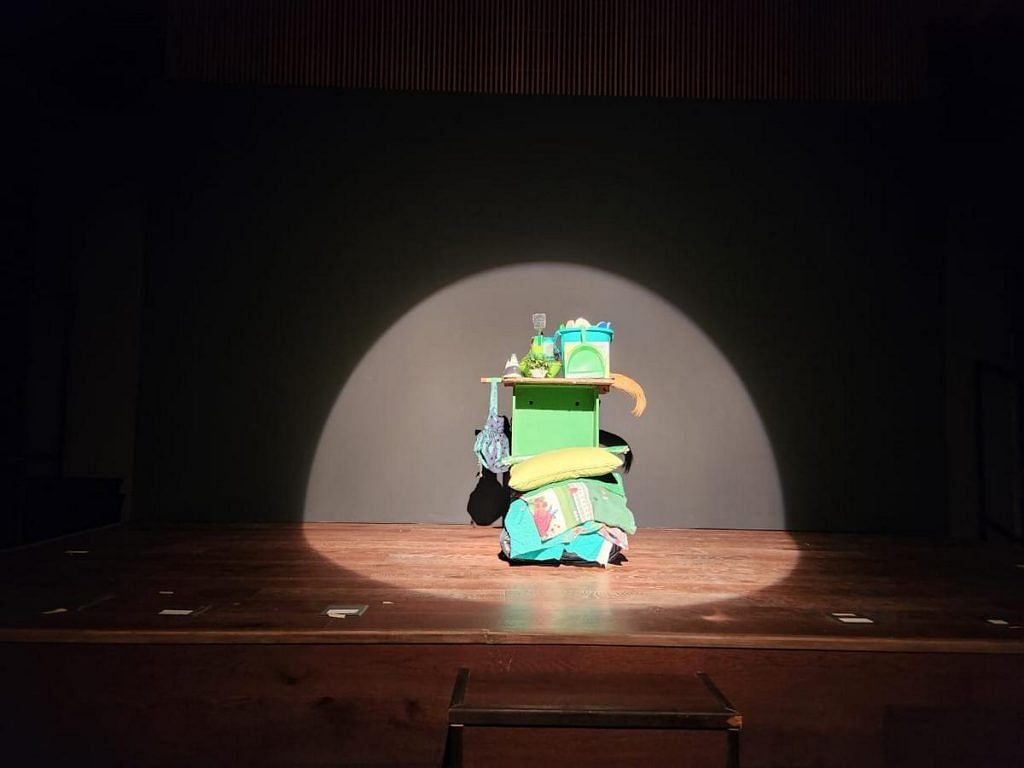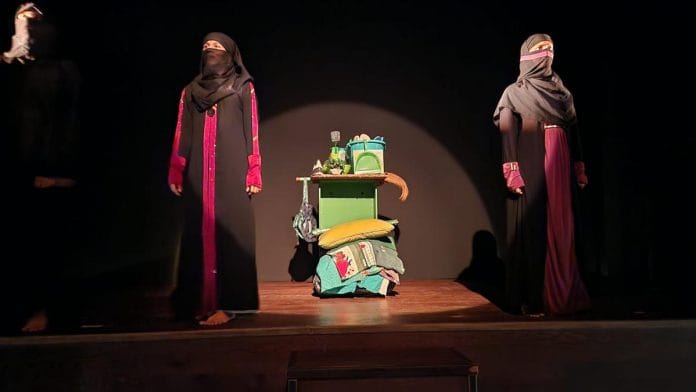New Delhi: Four young working-class Muslim women enter the stage wearing full-body black burqas that reveal just their eyes. They stare at the bewildered audience in silence for a couple of minutes. Then they suddenly fling their burqas off one by one. With that, their private worlds open up to the audience. A collective gasp follows.
These women, barely out of their teens, tell stories of their innermost turmoil, deepest dilemmas, and daily micro-mutinies as they take turns to sweep, mop, wash, and cook. In their aspirations and anxieties, they become Everywoman.
Bhaagi Hui Ladkiyaan (The Girls Who Ran Away) is a powerful and irreverent play staged as part of the Kiran Nadar Museum of Art’s first theatre festival in Delhi’s Sunder Nursery. The provocative title is inspired by Alok Dhanwa’s poem, and the play is directed and produced by the Aagaaz Theatre Trust, an NGO that works with underprivileged children in Nizamuddin Basti in the city. The festival is part of the museum’s performing arts department, and the theme of the inaugural event was ‘the power of vulnerability’.
“Imagine a day spent being a fly on the wall in Nizamuddin Basti. Eavesdrop on the lives of four young women,” said Kirtana Kumar, the curator of the festival of 13 plays. At its core, Bhaagi Hui Ladkiyaan is an enactment of the questions that confront young women everywhere: ‘Who am I?’ and ‘How do people see me’. It’s a study in contrast.
Also Read: Bharat Mata image, freedom struggle songs had videshi touch: Harvard Prof Sugata Bose
Real stories, changing script
This contrast is hard to miss from the get-go. The young women do house chores quietly against a backdrop of unceasing advertising jingles selling washing powders, fairness creams, hair products, beauty soaps, and low-fat breakfast cereals.
Then their stories come tumbling out. Each one is about daring to defy and dream against stifling odds.
One woman is the sole earning member in her family, but she doesn’t have the freedom to buy anything for herself. She returns home tired and faces mountains of clothes and dishes to wash. Her brothers idle their days and nights scrolling on their phones and live off her, even as they resent her.

Another woman has just cut her hair short and no longer wears her burqa, but has now become an embarrassment for her family as her community turns against her. They tell her nobody will marry her now. A third woman is an introvert, hyper-sensitive, and friendless. She supports her parents in Assam. She misses them, but won’t go there. She likes her work and freedom in Delhi. And the fourth protagonist tries everything to avoid the parental pressure of marriage with all kinds of made-up reasons, even as everybody undermines her by telling her how short, thin, and sickly she is.
As the stories end, the women break into a song and dance about how they don’t understand the rules. The song is called ‘Samajh nahin aata’. It’s about being told what to wear and what not to, how to behave in public, who to meet and speak to, about their malnourished bodies, and their unappreciated labour.
“These are our real stories,” said one of the women during an after-play interaction with the audience. “We decide which stories are important to tell, to process and find closure in at that time. We pick accordingly.”
The play has been staged around 30 times so far. Each time the script is improvised.
“As their lives change, their stories change too. We don’t have a fixed script,” said Dhwani Vij, the director of the play.
Breaking the burqa barrier
The 90-minute play flirts with class distances and questions of relatability.
At first, the burqa distances them from the audience. Then the characters get closer to the audience as their stories begin to resonate.
Once the stories end, there is a new trope used to engage and test the audience.
The young women invite audience members to come on stage. They show them various sites from their lives and ask them which parts they can relate to—the basti, the dargah, the mall, the autorickshaw, the Rapido, the household chores, the congested lanes of their neighbourhood, the street food, the parks, and the one-room homes. The audience members, mostly from relatively affluent backgrounds, are then asked to place little glow bulbs if they can relate. That is when the distance between the experiences of the audience and the actors become apparent.
In the end, the stage goes dark and the little bulbs glow in the dark on the spots where the audience members placed them.
In the silence that follows, the shared and unshared experiences are laid bare for everyone to see. Throughout the play, the distances shrink and expand at different times.
Also Read: Sindhis have been missing in India’s Partition story. Now, they finally get an exhibition
Theatre as transformation
The young women entered the world of theatre through the NGO, and now run community libraries for neighbourhood children as well. Over the years, theatre has changed their lives and given them a voice.
“We have become confident. I began when I was 8, today I am 24. I am still performing. Theatre has literally raised me. I am independent and am earning,” said one of the women. “I speak freely now, I never used to earlier. I can tackle all the problems now, that’s the confidence I have now.”
At one point in her story, she pointed out she doesn’t feel the need to have a man or marriage during the day. Work keeps her busy. She can take the world on. She lies to her parents that the NGO would make her pay a fine if she breaks the five-year contract to get married.
The night, however, is the only time she misses having a man, she said. The audience cheered loudly.
“If you are bhaagi hui ladkiyaan, let me say all of us have run away from some place,” said a woman from the audience.
the burqa never reappears in the play.
(Edited by Asavari Singh)







If regressive traits from Islam are used to suppress and abuse women, it should be portrayed as women are being abused in a Indian (not South Asian, that is reserved for anything good) context. If regressive traits in Tamil culture or Kerala culture are being used for the same, keep the same response. If any north indian Hindu women are being suppressed or abused, regardless of actual root cause, blame Hindu patriarchy. Eventually after Hinduism is removed, paint South asia as a regressive Muslim hinterland and suppress. The great western agenda.